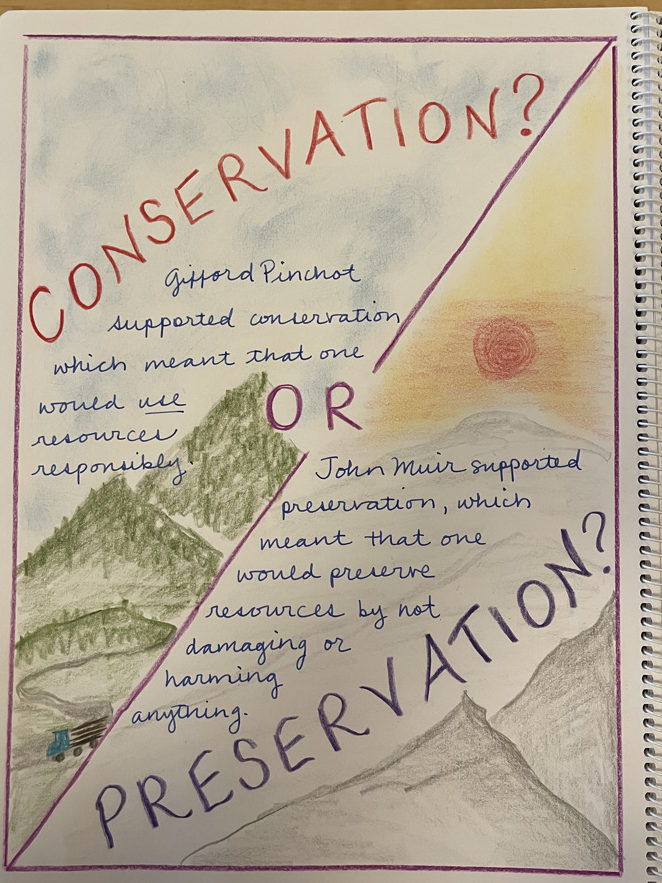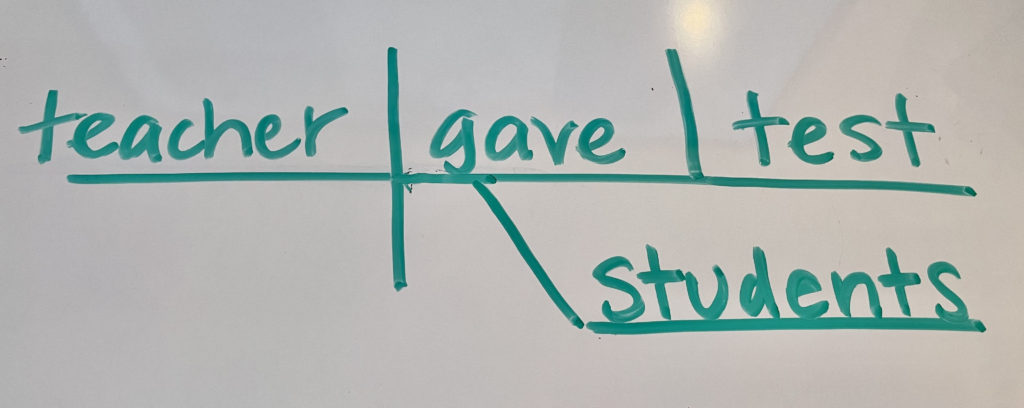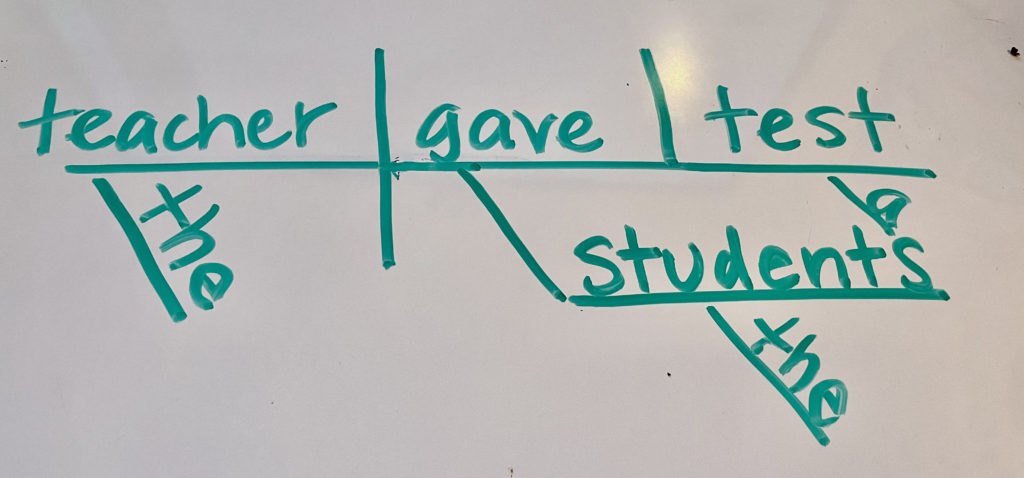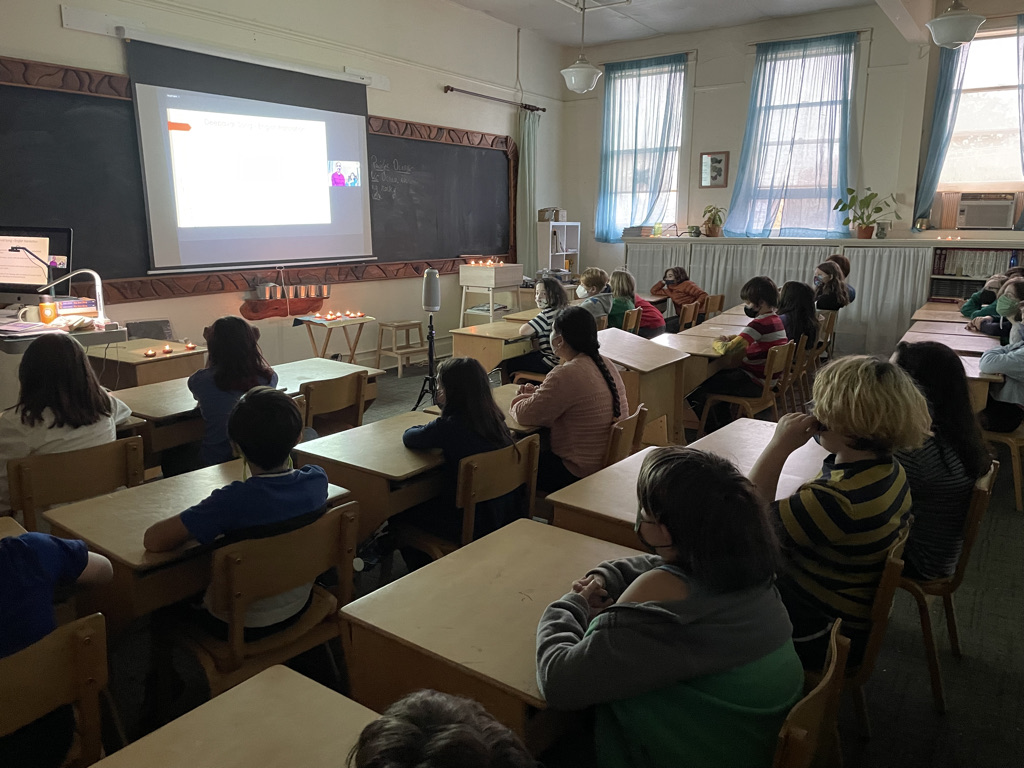Now that we’re all back together in person, the fifth graders and I have been diving into some pretty meaty content. And I have to say, it’s really been floating my boat.

We’re keeping up with our usual rhythm of dictations, compositions, guided drawings, and other fun activities peppered in, but for the past week we’ve been taking a close look at diagramming sentences.
At the risk of revealing myself to be a complete grammar nerd, I have to confess — I LOVE diagramming sentences. I’ve been using a number of online resources to help make sure I get it right. This one in particular has things spelled out pretty clearly.
But beyond what those resources have to share, I’ve figured out a few things that have made it easier for my students. It’s easiest to work it through with an example.
The teacher gave the students a test.
- Start by showing them how to identify the verb. I have found that the easiest thing for kids to identify in the sentence is the verb. Sometimes it’s a little tricky if the verb isn’t very active (like in this sentence) but most of my students can identify that “gave” is the verb in this sentence. Once they do that I tell them to underline the verb twice.
- From there, I say, “Who is doing the verb?” They can almost always get the subject from that. We underline the subject once, in this case “teacher.”
- Then I ask, “What is the teacher giving?” This is the direct object. We put the letters DO above “test” in this sentence. We sometimes have a chuckle about how it’s sometimes hard to tell when we have more than one noun after the verb. Is the teacher giving the test or the students? They love to imagine what it would be like if the teacher was giving the students to the test.
- Then I ask, “Who is receiving the test?” They can always get this — this is the indirect object and we put the letters IO above test.
Once we have all these parts identified, it’s time to do the diagramming. Some kids get intimidated and stuck at this step. They just don’t know where to start. I always tell them to start with the subject/verb cross.
I started with only diagramming the main parts that we identified, which would look like this.

I broke this down pretty carefully. We did a couple days of just subject and verb, then added the direct object and finally the indirect object.
Once they’d had enough practice with that, I started looking at the other words. They could pretty easily see how the other words in the sentence fit in. “The” went with teacher, “a” went with test, and “the” went with students. I showed them how those words fit into our diagram.

I was actually really surprised to see which students had a hard time with this and which ones found it to make complete sense. Some students who struggle with language arts in other ways, with either reading or writing, were the first ones with their hands in the air when it came to identifying the logic of how the words go together in the sentence.
By the end of the week, just about everyone could do it really well. There were only a few mistakes I saw on our end-of-week quiz.
- Some students put the “the” on the line next to teacher (logical mistake!)
- A couple kids put “students” right next to “test.” Again, that makes sense to me — who decided that the indirect object should go below and off the verb anyway?
- A couple of them left off the extra words and only did the subject, verb, direct object, and indirect object (again, makes sense because that’s how we started.)
I found the whole experience pretty satisfying, and I think they did too. On Friday when I excitedly commented on how well they got it, someone responded, “That’s because we have a really good teacher!”
Awww, sweet kids.
What’s next?
Well, after a very busy fall, I’m VERY much looking forward to Thanksgiving week. We take the first three days of the week to do parent-teacher conferences, which I’m also looking forward to, but then I’ll be having some family time at home.
It’s been a really busy fall (which you might have guessed by my lack of presence here.) I enrolled in a master’s program which I am absolutely loving, but I forgot how time-consuming being a student is! The time invested is paying off — I’m learning a lot and getting good grades.
After the break we’ll start with our first math block of the year — Decimal Fractions. This is my fourth time teaching fifth grade, so just typing that out brings to mind the progression of the block. That’s satisfying!
I know that we’ll start with a review of place value, at the same time as we do some work with fractions with 10 in the denominator. My students are just finishing up their review books on fractions, and though they won’t quite be done with them when we start the math block, it’ll be close. The perfect time to move on to decimals. I know that once they learn decimals they’ll be SO glad to leave traditional fractions behind.
Otherwise, things feel almost back to life as usual in the classroom. We’re wearing masks, but all my students are back in the classroom, they’re back to engaging in our lessons the way I expect (which was pretty tricky on Zoom), and we’re having fun (even though we have to eat our lunches outside, sometimes under drippy trees.)
Hope things are good in your neck of the woods, too.





Leave a Reply